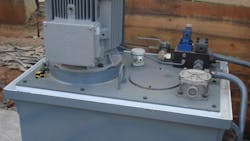How To Reduce Noise Emission From Hydraulic Systems
Many industrialized countries have regulations that restrict noise levels in the workplace. The high power density, and corresponding high noise emission of hydraulic components, means that industrial hydraulic systems are often the target of efforts to reduce mean noise levels in the workplace.
The dominant source of noise in hydraulic systems is the pump. The hydraulic pump transmits structure-borne and fluid-borne noise into the system and radiates air-borne noise.
All positive-displacement hydraulic pumps have a specific number of pumping chambers, which operate in a continuous cycle of opening to be filled (inlet), closing to prevent back flow, opening to expel contents (outlet) and closing to prevent back flow.
These separate but superimposed flows result in a pulsating delivery, which causes a corresponding sequence of pressure pulsations. These pulsations create fluid-borne noise, which causes all downstream components to vibrate. The pump also creates structure-borne noise by exciting vibration in any component with which it is mechanically linked, e.g. tank lid. The transfer of fluid and structure induced vibration to the adjacent air mass results in air-borne noise.
While fluid-borne noise attributable to pressure pulsation can be minimized through hydraulic pump design, it cannot be completely eliminated. In large hydraulic systems or noise-sensitive applications, the propagation of fluid-borne noise can be reduced by the installation of a silencer. The simplest type of silencer used in hydraulic applications is the reflection silencer, which eliminates sound waves by superimposing a second sound wave of the same amplitude and frequency at a 180-degree phase angle to the first.
The propagation of structure-borne noise created by the vibrating mass of the power unit (the hydraulic pump and its prime mover) can be minimized through the elimination of sound bridges between the power unit and tank, and the power unit and valves. This is normally achieved through the use of flexible connections i.e. rubber mounting blocks and hoses, but in some situations it is necessary to introduce additional mass, the inertia of which reduces the transmission of vibration at bridging points.
The magnitude of noise radiation from an object is proportional to its area and inversely proportional to its mass. Reducing an object's surface area or increasing its mass can therefore reduce its noise radiation. For example, constructing the hydraulic reservoir from thicker plate (increase in mass) will reduce its noise radiation.
The magnitude of air-borne noise radiated directly from the hydraulic pump can be reduced by mounting the pump inside the tank. For full effectiveness, there must be a clearance of 0.5 meters between the pump and the sides of tank, and the mounting arrangement must incorporate decoupling between the power unit and tank to insulate against structure-borne noise. The obvious disadvantage of mounting the hydraulic pump inside the tank is that it restricts access for maintenance and adjustment.
And if hydraulic system noise remains outside the required level after all of the above noise propagation countermeasures have been exhausted, encapsulation or screening may need to be considered.
Bottom line: excessive noise from hydraulic machines is often the result of design mistakes. And to discover six other costly mistakes you want to be sure to avoid with your hydraulic equipment, get "Six Costly Mistakes Most Hydraulics Users Make... And How You Can Avoid Them!" available for FREE download here.
About the Author
Brendan Casey Blog
Author
Brendan Casey is a war-weary and battle-scarred veteran of the hydraulics industry. He's the author of The Hydraulic Troubleshooting Handbook, Insider Secrets to Hydraulics, Preventing Hydraulic Failures, The Definitive Guide to Hydraulic Troubleshooting, The Hydraulic Breakdown Prevention Blueprint and co-author of Hydraulics Made Easy and Advanced Hydraulic Control. And when he's not writing about hydraulics or teaching it, Brendan is flat-out helping consulting clients from a diverse range of industries solve their hydraulic problems. To contact him visit his company's Website:
www.HydraulicSupermarket.com
